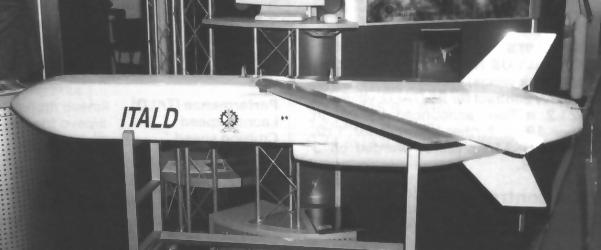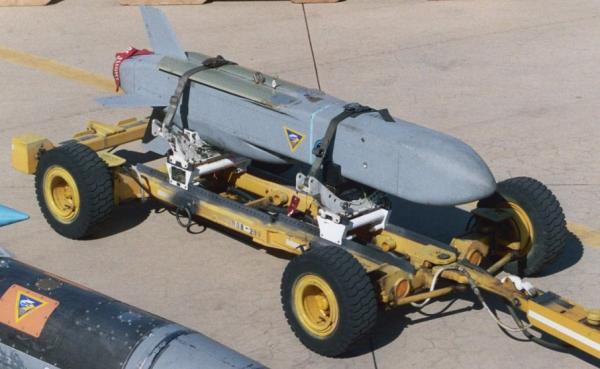IMI (Brunswick) ADM-141 TALD
The U.S. Navy's ADM-141 TALD (Tactical Air-Launched Decoy) is an unpowered glide decoy to confuse and saturate enemy air defenses. The ITALD (Improved TALD) is a turbojet-powered derivative.
In the 1970s, the Defense Division of Brunswick Corporation developed a line of unpowered radar decoy vehicles. One of these was the Samson, which was license-produced for the Israeli Air Force by Israel Military Industries (IMI) in the early 1980s. After the IAF had used the Samson with great success, the U.S. Navy bought more than 2000 Samsons between 1985 and the end of the 1980s. In December 1985, Brunswick received the first order from the U.S. Navy for an improved Samson named TALD (Tactical Air-Launched Decoy). TALD entered U.S. Navy service in 1987.
 |
| Photo: Brunswick |
| ADM-141A |
The basic TALD is an expendable unpowered glide vehicle with a square section fuselage, flip-out wings, and three tail surfaces. It has a digital flight control system which can be preprogrammed with various speed and manoeuvering profiles. Launched from high-altitude (max. 12200 m (40000 ft)), the TALD has a glide range of up to 126 km (68 nm), while the range at lower altitudes of about 600 m (2000 ft) is still around 26 km (14 nm). The basic TALD exists in several versions with different payloads. The A/B37U-1(V)1 is a chaff-dispensing vehicle carrying up to 36 kg (80 lb) of chaff, the A/B37U-1(V)2 is a passive radar decoy which uses a Luneberg lens the enhance its radar signature, and the ADM-141A uses both passive (Luneberg lens) and active (RF amplifier) radar enhancers. I don't know why the latter version was designated as a guided missile, when the two former ones were classed as aeronautical support equipment. The ADM-141B is also described as a chaff-dispensing TALD, but it is unclear whether this is a modified A/B37U-1(V)1 or simply a redesignation of the latter. There is also a TALD IR decoy, which uses a flare in the vehicle's tail, but this variant has apparently not received a U.S. military designation.
The majority of TALDs was produced in license by IMI, and by 1993 more than 4000 unpowered TALDs had been built for the U.S. Navy. The decoy was used very successfully in the opening stages of Operation Desert Storm in 1991, when more than 100 were launched to confuse and dilute Iraqi air defense systems.
 |
| Photo: Paul Jackson |
| ADM-141C |
In the early 1990s, Brunswick began development of the Improved TALD (ITALD), powered by a Teledyne CAE Model 312 (J700-CA-400) turbojet. The propulsion system offers significantly increased range (more than 300 km (160 nm) at high and 185 km (100 nm) at low altitude) and much more realistic flight profiles like a high-speed low-level approach followed by a sharp pop-up manoeuver. The initial contract called for conversion of twenty TALDs to ADM-141C ITALD configuration, and the first of these flew in 1996. By that time, IMI had purchased the full rights for the TALD family of decoys, and is now prime contractor for all variants. Since late 1996, U.S. Navy has ordered at least 200 ADM-141Cs from IMI, and plans have been announced to integrate a GPS-aided inertial navigation system in future ITALDs.
 |
| Photo: Kaston/Skyshadow |
| ADM-141C |
The primary carrier aircraft for the ADM-141 is currently the F/A-18 Hornet. Using TERs (Triple Ejector Racks) or MERs (Multiple Ejector Racks), a single dedicated aircraft can carry up to 20 decoys.
Specifications
Note: Data given by several sources show slight variations. Figures given below may therefore be inaccurate!
Data for ADM-141A/C:
| ADM-141A | ADM-141C | |
|---|---|---|
| Length | 2.34 m (7 ft 8 in) | |
| Wingspan | 1.55 m (5 ft 1 in) | |
| Weight | 180 kg (400 lb) | ? |
| Speed | > 460 km/h (250 kts) | Mach 0.8 |
| Range | 126 km (68 nm) | > 300 km (160 nm) |
| Propulsion | none | Teledyne CAE J700-CA-400 turbojet; 790 N (177 lb) |
Main Sources
[1] Norman Friedman: "World Naval Weapons Systems, 1997/98", Naval Institute Press, 1997
[2] Kenneth Munson: "World Unmanned Aircraft", Jane's, 1988
[3] Kenneth Munson (ed.): "Jane's Unmanned Aerial Vehicles and Targets, Issue 15", Jane's, 2000
Back to Current Designations Of U.S. Unmanned Military Aerospace Vehicles
Back to Directory of U.S. Military Rockets and Missiles
Last Updated: 19 October 2006